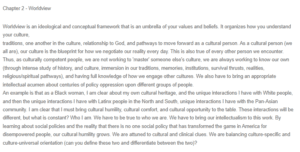Culture-Specific Orientations and Culture-Universal Orientations
Culture-specific orientations refer to the ways in which persons from different cultures identify and construe the world around them. These orientations are shaped by cultural values, beliefs, and norms, and they influence various aspects of human behavior, communication, and interaction. Examples of culture-specific orientations include individualism vs. collectivism, power distance, uncertainty avoidance, and other dimensions identified by cultural theorists such as Geert Hofstede. Conversely, culture-universal orientations refer to common human behaviors, values, or orientations shared across cultures (Little et al., 2014). While significant cultural differences exist, certain aspects of human experience and behavior are considered universal, going beyond cultural boundaries. Culture-universal orientations include language and communication, dressing, social structure, family, education, basic human needs, such as food, emotions, socialization, tool use, and art and aesthetics.
There are clear differences between these two cultural orientations. The first difference is the variability in culture-specific orientation and the consistency in culture-universal orientation. In cultural universal orientation, all cultures have developed some form of language to convey thoughts, emotions, and information. However, in culture-specific orientation, communication becomes highly specific. For instance, in high-context cultures, communication relies heavily on non-verbal cues, shared experiences, and implicit understanding (Broeder, 2021). On the other hand, low-context cultures emphasize explicit communication and rely on clear verbal expression. Different societies may prioritize and emphasize different values based on their historical, social, and environmental contexts.
The second difference is that culture-universal orientations are foundational traits. They represent fundamental human traits and behaviors inherent to the human species, regardless of specific cultural influences. George Murdock, a renowned anthropologist, was the first to recognize that cultural universals existed and that they almost always revolved around basic human survival (Ezeugo, 2022). These traits include food, experiences such as birth and death, and shelter. Contrariwise, culture-specific orientation tends to be more about learned behaviors. This means individuals within a specific culture learn and internalize these orientations through socialization, upbringing, and exposure to cultural norms and values. For example, some cultures may emphasize both masculine and feminine qualities (moderate), while others may strongly prioritize one.
References
Broeder, P. (2021). Informed communication in high-context and low-context cultures. Journal of Education, Innovation, and Communication, 3(1), 13-24.
Ezeugo, A. E. (2022). Cultural discord, hostility, and destructive consequences: Dramatic perspectives. Chukwuemeka Odumegwu Ojukwu Journal of Folklore and Cultural Studies, 1(1).
Little, W., Vyain, S., Scaramuzzo, G., Cody-Rydzewski, S., Griffiths, H., Strayer, E., & Keirns, N. (2014). Introduction to sociology-1st Canadian edition. BC Campus: Victoria, BC, Canada.
ORDER A PLAGIARISM-FREE PAPER HERE
We’ll write everything from scratch
Question

Culture-Specific Orientations and Culture-Universal Orientations
Chapter 2 – Worldview
Worldview is an ideological and conceptual framework that is an umbrella of your values and beliefs. It organizes how you understand your culture,
traditions, one another in the culture, relationship to God, and pathways to move forward as a cultural person. As a cultural person (we all are), our culture is the blueprint for how we negotiate our reality every day. This is also true of every other person we encounter. Thus, as culturally competent people, we are not working to ‘master’ someone else’s culture, we are always working to know our own (through intense study of history, and culture, immersion in our traditions, memories, institutions, survival thrusts, realities, religious/spiritual pathways), and having full knowledge of how we engage other cultures. We also have to bring an appropriate intellectual acumen about centuries of policy oppression upon different groups of people.
An example is that as a Black woman, I am clear about my own cultural heritage, and the unique interactions I have with White people, and then the unique interactions I have with Latinx people in the North and South, unique interactions I have with the Pan-Asian community. I am clear that I must bring cultural humility, cultural comfort, and cultural opportunity to the table. These interactions will be different, but what is constant? Who I am. We have to be true to who we are. We have to bring our intellectualism to this work. By learning about social policies and the reality that there is no one social policy that has transformed the game in America for disempowered people, our cultural humility grows. We are attuned to cultural and clinical clues. We are balancing culture-specific and culture-universal orientation (can you define these two and differentiate between the two)?

